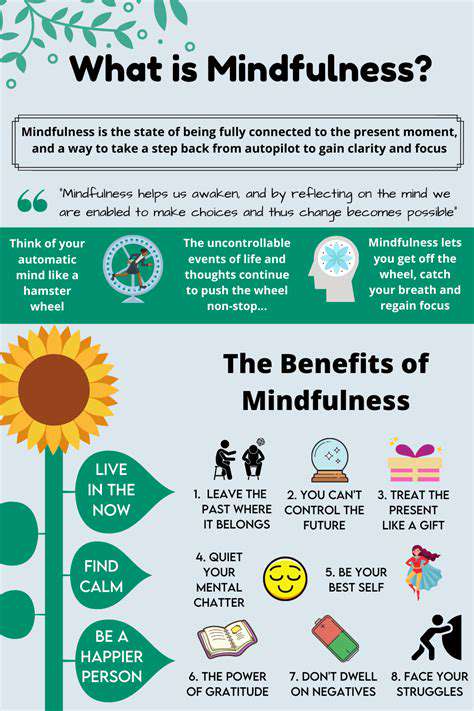Recognizing Physical Symptoms as Indicators of Anxiety
The Connection Between Anxiety and Physical Symptoms

Understanding Common Physical Symptoms of Anxiety
Anxiety can manifest in various physical forms, ranging from mild discomfort to severe reactions. Understanding these symptoms is crucial for recognizing when anxiety may be affecting your health. Common symptoms include rapid heartbeat, gastrointestinal issues, and muscle tension.
These physical responses are often the body’s way of signaling that something is amiss. For example, a rapid heartbeat can be triggered by the body's fight-or-flight response, while gastrointestinal issues might arise from stress-induced changes in digestion.
Identifying these symptoms early can help individuals seek the appropriate support. Managing physical symptoms can contribute significantly to overall anxiety relief and improve quality of life.
The Role of Stress in Amplifying Physical Symptoms
Stress plays a significant role in amplifying the effects of anxiety on the body. When a person experiences stress, it can lead to heightened anxiety symptoms, including fatigue and headaches. Recognizing the interplay between stress and anxiety is vital for effective coping strategies.
Moreover, chronic stress can lead to several health issues, including cardiovascular problems and a weakened immune system. This connection emphasizes the importance of addressing stressors in one’s life to mitigate physical symptoms related to anxiety.
Incorporating stress-reduction techniques such as mindfulness, deep breathing, or regular exercise can be beneficial. These practices not only help alleviate physical symptoms but also promote a greater sense of emotional well-being.
Increased Heart Rate and Shallow Breathing
Understanding the Body's Response to Anxiety
Anxiety triggers a biological response commonly known as the "fight or flight" response. This reaction is meant to prepare the body for a perceived threat. When anxiety arises, the body releases stress hormones like adrenaline and cortisol, which affect various physiological responses.
One of the immediate effects of this response is an increased heart rate. The heart pumps faster to circulate blood more effectively to vital organs and muscles, preparing the body to take action. However, this rapid heartbeat can often feel alarming, especially in calm environments.
Alongside a racing heart, shallow breathing frequently accompanies anxiety. Instead of taking deep breaths that fill the lungs, individuals may find themselves taking shorter, more rapid breaths, which can lead to feelings of lightheadedness or dizziness.
Acknowledging these physical symptoms is critical. By recognizing them as indicators of anxiety rather than a medical emergency, individuals can learn to manage their anxiety more effectively.
Understanding these physiological responses is the first step in developing coping strategies, such as deep-breathing exercises or mindfulness techniques, to help soothe anxiety-related symptoms.
The Connection Between Anxiety and the Respiratory System
Shallow breathing, often linked with anxiety, may originate from a hyperactive nervous system. When individuals are anxious, their body may constrict muscles around the chest, limiting the depth of their breaths. This can exacerbate feelings of panic or unease.
Chronic shallow breathing can lead to a cycle of anxiety where individuals become more aware of their breath and, in turn, feel more anxious about it. It's crucial to break this cycle through intentional breathing practices.
Breathing techniques, such as diaphragmatic breathing or the 4-7-8 method, can help counteract shallow breathing. By consciously engaging the diaphragm, individuals can facilitate deeper breaths, increasing oxygen intake and promoting a sense of calm.
Education about the body's respiratory response to anxiety can empower individuals. Understanding that shallow breathing is a common, albeit uncomfortable, symptom allows for better management and reduced fear around the symptom itself.
As a result, building awareness and practicing deep breathing techniques can ultimately lead to decreased anxiety levels and a more balanced emotional state.
Physical Manifestations of Anxiety: Why They Matter
Physical symptoms of anxiety are not merely inconveniences; they are clear signals from the body. Recognizing these symptoms can aid in early identification of an anxiety episode, allowing individuals to take proactive measures.
The significance of these symptoms extends beyond discomfort. Increased heart rate and shallow breathing can lead to long-term health effects if anxiety is left unchecked. For instance, prolonged high heart rates may contribute to cardiovascular issues, while shallow breathing may decrease lung capacity over time.
By addressing these physical manifestations, individuals can mitigate potential health concerns and enhance overall quality of life. Regular exercise, proper nutrition, and adequate sleep are essential for reducing anxiety's physical symptoms and promoting emotional well-being.
Moreover, creating an environment that supports stress reduction — such as engaging in hobbies, maintaining social connections, and practicing relaxation techniques — can further alleviate physiological symptoms associated with anxiety.
Ultimately, recognizing and responding to physical symptoms of anxiety can empower people to take control of their mental health, reducing the impact of anxiety on their daily lives.
Strategies for Managing Physical Symptoms of Anxiety
Managing physical symptoms of anxiety requires a multifaceted approach. The first step is awareness; individuals should learn to identify their symptoms early on, which can help in developing effective coping strategies.
One proven technique is progressive muscle relaxation, which involves tensing and then relaxing different muscle groups. This practice can lower overall tension in the body and promote a sense of calm.
Mindfulness meditation is another highly effective strategy. It encourages individuals to focus on their current experiences, including physical sensations, without judgment. This practice can lead to greater awareness of anxiety and reduce the power it has over one's emotional state.
Incorporating regular physical exercise into a daily routine can also serve as a potent anxiety management tool. Physical activity releases endorphins, which are natural stress relievers and promote an overall sense of well-being.
Lastly, seeking support from mental health professionals can provide additional strategies tailored to individual needs. Therapy options such as cognitive-behavioral therapy (CBT) can help individuals challenge their irrational fears, ultimately leading to greater control over anxiety symptoms.
When to Seek Professional Help for Anxiety Symptoms
While managing anxiety through self-help strategies can be effective for many, there are times when professional help is vital. If physical symptoms of anxiety persist or escalate, seeking professional support is essential.
Signs that professional intervention is needed include experiencing intense physical reactions that disrupt daily activities, or when anxiety significantly affects one's quality of life. This may manifest as reluctance to participate in social situations, work performance decline, or avoidance of responsibilities.
Individuals may also consider seeking help if self-management strategies do not lead to improvement. A mental health professional can offer tailored treatment plans that address both the emotional and physical aspects of anxiety.
Moreover, it’s essential to seek assistance when physical symptoms become unbearable, such as constant palpitations, difficulty breathing, or persistent dizziness. Ignoring these symptoms can lead to complications, making timely intervention crucial.
Ultimately, seeking professional help is a sign of strength and an important step towards healing. With the right support, individuals can learn to navigate their anxiety effectively, promoting emotional and physical health.
The Importance of Mindfulness and Awareness

The Role of Mindfulness in Recognizing Symptoms
Mindfulness practices help individuals become more attuned to their bodies and emotions, providing a clearer picture of physical symptoms that may indicate anxiety. By engaging in mindfulness activities such as meditation or deep breathing, one can develop a greater awareness of physiological responses that accompany anxious feelings.
Furthermore, regular mindfulness practice can create a space for self-reflection, allowing people to differentiate between normal stress and more concerning symptoms. This differentiation is crucial in managing anxiety effectively and can assist individuals in seeking appropriate help when needed.
Common Physical Symptoms of Anxiety
Anxiety often manifests in various physical symptoms that can be misleading if not properly recognized. Symptoms such as rapid heartbeat, sweating, or muscle tension are frequently overlooked because they may be dismissed as typical stress responses.
Understanding these symptoms can empower individuals to address their anxiety proactively. For instance, being aware that a racing heart might signify anxiety can lead to healthier coping strategies and prevent the escalation of anxiety into a full-blown panic attack.
Building Awareness Through Body Scan Techniques
Body scan techniques are effective tools in developing awareness of bodily sensations associated with anxiety. By systematically focusing on different parts of the body, individuals can uncover areas of tension or discomfort that are often linked to anxiety.
This practice not only promotes relaxation but also fosters a deeper understanding of how anxiety affects the body. Ultimately, increased awareness can lead to more effective management strategies and a reduction in the overall impact of anxiety on daily life.